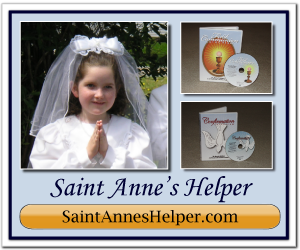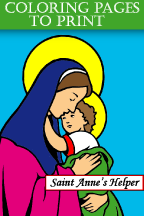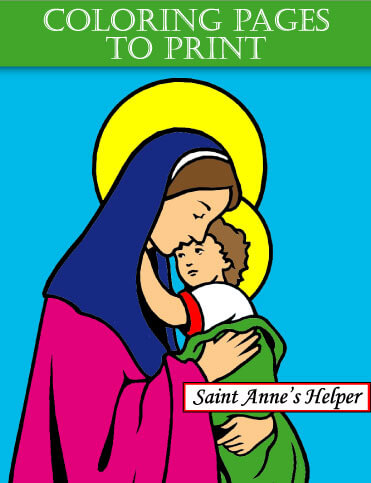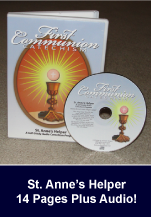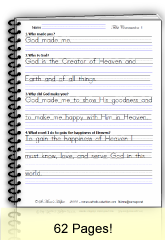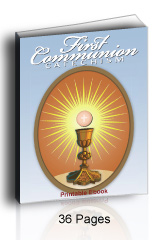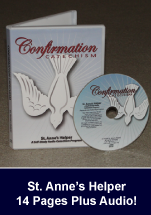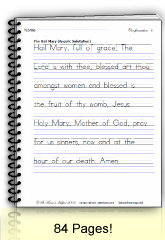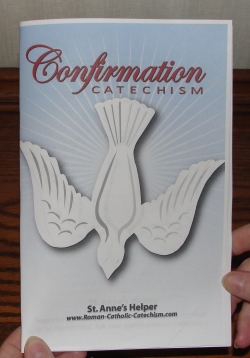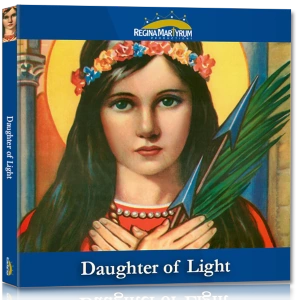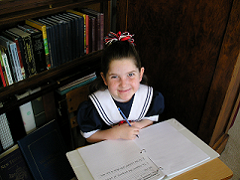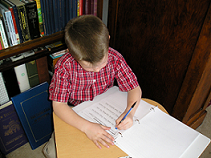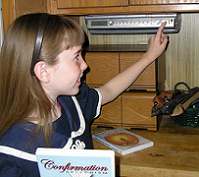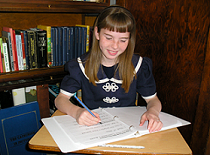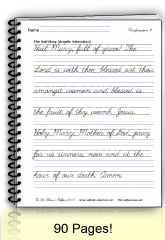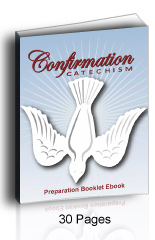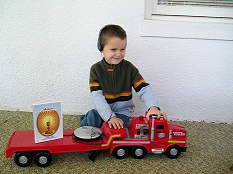- Home
- Baltimore Catechism
Baltimore Catechism Catechesis
Catholic Answers & Prayers
The Traditional Roman Catholic Catechism In The United States
I can remember the first time I read an older Baltimore Catechism. I was in my twenties. I wondered, "Where was this all of my life?!"
- I could have answered Sr. Mary Divisive so many ways.
- I could have answered Sr. Mary Smartie Pants in tenth grade when she opened up a 4 month long classroom "debate" on abortion. Oh! How I wish that I could have told her what my favorite teacher in college had said, "Abortion is murder." So simple.
I was so struck by Father's words in college that I immediately wrote those three words around the margin of my notes - several times!
Needless to say, I am very happy to have found traditional Catholic catechisms for our own children. Click these links for quick reference on this page:
- First Communion
- Confirmation
- 1880s and now
- Some improvements in the 40s and 50s
- Trent
- Deharbe's Catechism
- Adult catechism books
- PDF online digital worksheets and coloring pages
- Baltimore Catechism Ten Commandments
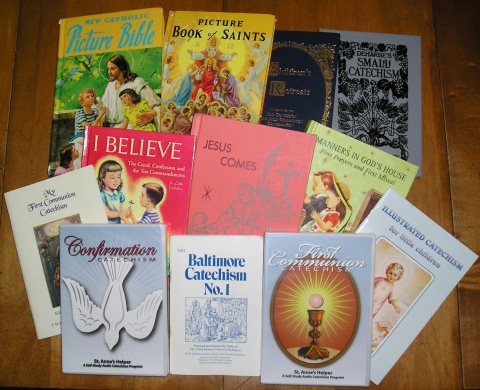 1880s and 1950s Baltimore Catechism audio CDs and booklets.
1880s and 1950s Baltimore Catechism audio CDs and booklets.Baltimore Catechism Books
The BC is an effort to convey the Roman Catechism in our language. It is the main Catholic catechism for catechesis in English.
Catechesis For Children
Baltimore Catechism for Children
BC First Communion PDF Worksheets
Will The Real Baltimore Catechism Please Stand?
The Baltimore is not as hard to find as it used to be as it is available online and you can buy the booklets from most any Catholic bookstore.
The Baltimore makes common issues plain and simple so that it is easier to know, love, and serve God.
But - there are so many versions. Which version should you use? I'll explain the main books in the picture above throughout this page and the BC pages that are linked from this page.
Gradually, I'll take you through First Communion and Confirmation to high school and adult level versions of the Baltimore.
When you're teaching, you can use our Saint Anne's Helper worksheets, audios, and coloring pages to help your students memorize or review.
Use the Baltimore Catechism?
Disclosure: I show products that I think will help you. If you use my links, I may earn ad commissions at no extra cost to you. As an Amazon Associate I earn from qualifying purchases.
The Best Baltimore Catechism Resources
The Baltimore and DeHarbe's old catechisms are the easiest to use in both classroom and homeschool situations.
Because they're both English versions of The Catechism of the Council of Trent, they're super similar. See more in section 5 below.
TAN Books Baltimore Catechism Complete Set At Amazon
Disclosure: I show products that I think will help you. If you use my links, I may earn ad commissions at no extra cost to you. As an Amazon Associate I earn from qualifying purchases.
Small and Large Deharbe's Catechism
If you are not required to use the Baltimore, check out the old version of DeHarbe's Catechism at Amazon. The Small Catechism is for Communion preparation and The Large Catechism is for the rest of us. No Wite-Out necessary. :-)
1. First Communion Baltimore Catechism
Converts and Lower Grade School
If you are new to the faith or are teaching children about Communion, the First Communion Catechism is what you want to use. You can see different First Communion Catechisms here.
Proper Age to Teach The First Communion Baltimore Catechism
For the prayers and Ten Commandments, an appropriate age to start learning the Baltimore Catechism is as soon as a child can pronounce the words well.
Be forewarned. It is hard to correct baby pronunciations later.
Certainly, most children should know their prayers by kindergarten and first grade, especially if they learn them with the family Rosary.
The Rosary prayers are the main prayers learned for First Communion, plus the Act of Contrition. The old Baltimore teaches the Perfect Act of Contrition, in my opinion the best Act of Contrition prayer out there.
On top of that, it is very handy if they would know the prayers the year before they study the other questions for First Communion. This makes much less work to do during the First Communion year. It removes a lot of stress from teachers, parents, and students.
First Communion Catechism
For First Communion? Most children learn the questions from the Baltimore Catechism No. O or No. 1 in First or Second Grade (6 to 9 years old). If you have the No. 2, you've got the same info because the #0 and #1 are from the #2.
Kids do not always have to memorize every answer, yet it is important that they know and understand the prayers
- Act of Contrition,
- The Hail Mary,
- The Our Father, and
- The Catholic Ten Commandments for their
- First Confession.
You'll love having these Catholic coloring pages for teaching the sacraments, saints, and feast days throughout the Communion year.
Need help teaching? Saint Anne's Helper First Communion audio, worksheets, and e-booklets cover the main Catechism answers and prayers.
Word Game: What is catechesis?
Catechesis Definition
What's the definition of catechesis? The definition of catechis is:
- Catechesis is the teaching of the catechism to others.
Simple. It's a name game with several words having the same root or base.
A catechist teaches the catechism to catechumens (or the Latin catechumeni). The first six letters are the same.
How do you pronounce catechesis?
The pronunciation is
- cat eh key sis
The second e says its long vowel sound.
Kinds of Catechisis
The kind of catechetical instruction depends on whom or what you're teaching.
- If you're teaching about Baptism, the Eucharist and Confirmation, it's sacramental catechesis.
- If you're teaching adults, it's adult catechesis.
- If you're teaching children, it's catechesis for children.
- If you're teaching the liturgy, feast days, the Gospel, etc; they're ligurgical catechesis, Gospel catechesis, and Bible catechesis, etc.
It's all the same Catholic catechism principles no matter the name or how old your students are.
2. Baltimore Catechism Confirmation Class
Converts, Middle School, and High School
If you or those you are teaching have already been Baptized and received Communion, you'll want to use our Saint Anne's Helper Confirmation Catechism.
It teaches about the Holy Trinity, the sacraments, and more on the graces on which we can depend every day to be strong in our faith. The Confirmation catechism also reviews the main Catholic prayers and the Ten Commandments.
For Confirmation you'll also want to have books on the saints so that you know which patron saint you will choose for your Confirmation name, as is traditional; or to know more about your name saint if you will be using your own name.
Most saint names have several saints and variations: Teresa of Avila, Therese of Lissieux; Thomas the Apostle, Thomas of Canterbury, Thomas Aquinas, Thomas More, etc. See more about Catholic saints here and Confirmation names here.
The Proper Age to Teach the Baltimore Catechism for Confirmation
Usually Catholic children are confirmed from third to eighth Grade (9 to 14 years old), although in recent years some dioceses have moved the age for Confirmation to 18 years old. (!)
For Confirmation? The Baltimore Catechism questions on the Blessed Trinity, Redemption, and the questions related to the sacrament of Confirmation are usually required and are found in the BC No. 2.
The No. 0 and 1 are taken from the No. 2, so if you already own the No. 2 you would not need to buy the lower numbered booklets.
The main prayers that you want to add for Confirmation students to learn beyond the Communion prayers above are the:
- The Apostles Creed,
- The Confiteor,
- The Hail Holy Queen,
- The Acts of Faith, Hope, and Charity.
- And some Confirmation Prayers.
If you need help teaching your students or helping your children memorize these prayers, you will find that Saint Anne's Helper Confirmation audio, digital worksheets, and e-booklets cover the main questions and prayers asked in Confirmation class in a super helpful way.
3. Old Versus New Baltimore Catechism
3.A. Old Baltimore Catechism 1885
The original edition of the old Baltimore Catechism is the most widely known and best trusted catechism, and has the easiest answers to memorize. The answers are short and clear.
On top of that it has the most beautiful prayers. It keeps the thees and thous and other lovely words that we seldom see today.
The info in the BC Nos. 1-2 are the same. Again, if you own the No. 2 you'll have the info in the No. 0 and the No. 1. I explain further differences here:
- Baltimore No. 1 (a subset of BC No. 2)
- Baltimore No. 2 - has most of the truths most Catholics ever need to learn.
- Baltimore No. 3 - Complete for high school or adults.
- Baltimore Catechism for Children
- Audio Baltimore CD Verbatim BC No. 1 recording (contains many BC2 Questions) great for review and audio learners.
- Adult Baltimore Catechism - Several good choices.
- Saint Anne's Helper Baltimore Catechism: First Communion and Confirmation audio, worksheets, and ebooklets.
There were a few questions in the old Baltimore that had "iffy" answers, especially the question on the purpose of matrimony. This was later settled in the 1917 Code of Canon Law.
The earlier difficulty with matrimony was to rear its head again with the changes leading to Vatican II. See about the New Saint Joseph version below in section 3.C..
- "When Pope John XXIII announced the creation of the Second Vatican Council (also known as Vatican II) in January 1959, it shocked the world. There hadn't been an ecumenical council — an assembly of Roman Catholic religious leaders meant to settle doctrinal issues — in nearly 100 years.
- "Many people maintained that with the definition of papal infallibility in 1870, councils were no longer needed. So it was a big surprise...." NPR.org
3.B. The New Baltimore Catechisms
One would think that the Catholic faith is the Catholic faith. Right?
The first time the Baltimore Catechism was changed was in the 1940s with the Confraternity of Christian Doctrine version (CCD).
A few words were changed that made small material differences. Many versions began to offer Baltimore Catechism illustrations. Bible quotes were added. Here is the beginning of today's problems. Why?
- Some versions introduced beautiful images and others offered impolite pictures and haggard art.
- The CCD produced a new version of the Bible beginning in 1941 with the most important parts of the Bible, the beginning of the Old Testament and the full New Testament. The CCD did not stop changing the texts till 1969 when it chose to use the New American Bible (NAB).
So. Whatever on Bible quotes being added to the catechism books.... See more about the changes in the Bible here.
The Living My Religion and Our Holy Faith series stayed fairly close to the old catechism. See more below in section 4.
3.C. The New Saint Joseph Baltimore Catechism
The New Saint Joseph Baltimore Catechism series by Catholic Book Publishing Company may seem old, yet it was first published in 1963 which is relatively recent.
There have been many serious changes in this catechism between the 1960s and now. Most prominent are its version of what happened at the Resurrection and the Ascension.
The 2012 edition is the first where Catholic Book Publishing Company marked the date of the changes. It is the main version available today.
I describe the changes in The New Saint Joseph Baltimore Catechism in this three part article each with five to ten photos for "a look inside" the older versins on each page.
- Part 1: Catholic Catechism Changes: Baltimore 1885 to 2012 (5 photos)
- Part 2: NSJBC Catechism For Children - Article with list of Catholic Sunday school changes and comparisons (10 pictures)
- Part 3: NSJ for First Holy Communion, No. 1 And No. 2 Comparison of Catholic catechism for children changes (8 images)
Buy Our Saint Anne's Helper Ad-free PDF Catholic Coloring Pages to Print
Over 200 Catholic digital pictures to print.
Bonus: Christmas, Easter, animals, patriotic and more! Catholic Coloring Book Download. Ad-free PDF.
If you use the Baltimore Catechism, you'll love Saint Anne's Helper!
3.D. Teaching The Baltimore Catechism
The old Baltimore Catechism had been the basic catechism Catholic Church publishers used in the USA ever since the 1880s. It spared the fluff so the answers were easy to memorize. It was "originally issued by the Third Plenary Council of Baltimore in 1885" (Inside jacket cover, Baltimore Catechism No. 2 , Tan Books).
Even today, most BC versions use more good definitions than other popular catechisms: Baptism "is", Confirmation "is", etc. rather than the subjective "What does Baptism do for you?"
Until our oldest was preparing for First Holy Communion, I hadn't known anyone that had had to memorize the Ten Commandments. I know that I knew them well enough to make my first confession, but I hadn't memorized them word for word.
Looking back I sure wished that I had memorized them before our oldest child started learning them, it would have made it easier for me to teach her. If you can memorize the answers, do. You'll find teaching the catechism so much easier.
I always had to have a copy in my hands before I dared try to say them with her, although maybe that's a good idea anyway. There were many times when I made a mistake and that is what stuck in my child's mind. That's so hard to undo!
My folks had always said the family Rosary, so I already had known the prayers well. As a family, we did the same for our children. If your children know the Rosary prayers before catechism class, they will already know the main prayer requirements in the BC. The trick here is to be certain that they say the words well.
Otherwise, the main thing is to practice saying the answers frequently. Help them to learn the specific wording as it is very helpful in later life to know the full answers.
Our First Communion and Confirmation downloads can be a huge help to both yourself and the children for review and memory work. They also include a copy to print so you have the actual words handy.
3.E. In General The Baltimore Catechism Covers:
- The Roman Catholic beliefs.
- Catholic Prayers including the Rosary.
- Ten Commandments.
- Catholic Sacraments.
- God the Father, Creator of Heaven and Earth and all things. (Bible Creation)
- Jesus Christ, the Son of God, Our Savior. (Christmas, Lent, Easter)
- Holy Spirit, the Sanctifier. (Pentecost)
- The Blessed Virgin Mary, Saint Joseph, and other saints.
- Original sin, mortal sin, and venial sin.
- The theological virtues. (Acts of Faith, Hope, and Charity)
- Spiritual and corporal works of mercy.
The numerical order of the books originally followed throughout the series which began with 0 (zero). The No. 0 was the First Communion Catechism in the 1940s. The other levels had more questions and answers as "levels" would require for those teaching children through the school years.
The No. 2 has all the questions from the No. 0 and the No. 1. If you're starting to use the BC with older children simply start with the No. 2. It covers all the basics of any Catholic catechism and every question of the Nos. 0 and 1.
Adult converts, or those Catholics wishing to relearn their catechism, would read one of either the No. 3, or No. 4. These last simply go into greater detail and have more complete answers than the No. 2. See more adult catechisms here.
Me? As an adult I have found that The Catechism of the Council of Trent (CCT) itself or The Catechism Explained were very helpful and would use them rather than the No 3. See more on these below.
The BC was founded on the CCT in the first place and The Catechism Explained uses the BC and adds more Bible stories, counsel, and historical research than the CCT.
The Baronius Press and TAN Books new Baltimore Catechism editions seem to be verbatim to what TAN used to sell in its early days.
Pro Multis Media has a verbatim audio Baltimore CD for the BC No. 1 (see CD and books below).
3.F. Baltimore Catechism: What is God's Will?
The Baltimore Catechism, like any good catechism, teaches God's Will. What is God's Will for me?
- Why do I exist?
- What is the purpose of life?
- What am I supposed to do?
- How do I know God's Will for me?
The BC teaches me to know, love and serve God in order to be happy with Him in Heaven. Being happy with Him in Heaven is why we exist.
How do I know God's will for me personally, especially if I should not "interpret the Scriptures" to my own "perdition" as according to the book of St. Peter? Knowing the answers in the catechism, staying in the state of grace, praying, and keeping a good spiritual life are the beginning.
We know Him, love Him, and serve Him when we
- Obey His Commandments,
- Believe the Apostle's Creed, and
- Obey the precepts of the Catholic Church.
These ask us to obey our lawful superiors and practice the virtues. Certitude is as easy as this! This is how we know God's Will. If we violate these, we disobey God's will.
Some people spend a lifetime wondering these answers that they could have learned in First Communion class. We learn what God wants through the Catholic Church, so I heartily recommend that even adults read a child's BC to learn the basics. It is wonderful that parents learn the Faith at the same time as their children, yet think how much better it would have been if they'd known before.
- Do the Ten Commandments,
- The Six Precepts,
- Pray, and
- Practice the virtues.
We know His will through the Catholic Church. Jesus Christ formed His Church and the Holy Ghost sanctifies her so that we can learn and keep the Faith.
Remember that God's Will is adorable and ours is not (often). Obedience is a virtue.
God honors obedience even to the point of miracles! Think of St. Vincent Ferrer who had been performing "too many" miracles for the peace of his religious community that his superior ordered him to stop.
When St. Vincent saw a man falling from a scaffolding full of bricks he stopped mid-miracle remembering that he wasn't supposed to work a miracle. He left the man suspended while he ran to ask permission of his superior.
Of course, the superior said "Yes!" His devoted obedience made two miracles.
Over 200 Catholic digital pictures to print.
Bonus: Christmas, Easter, animals, patriotic and more! Catholic Coloring Book Download. Ad-free PDF.
3.G. The Baltimore Catechism Gives Certitude!
A traditional Roman Catholic catechism teaches the Catholic answers succinctly with definitions. There's little fluff. If you need an answer, you can often find it in one sentence.
Also, it is objective. Instead of asking in a subjective manner: "What does Baptism do for YOU?" or "What does Confirmation do for YOU?" the BC answers ask and teach "What IS Baptism?" and "What IS Confirmation?" You'll know the objective answer. (Note: These sacraments essentially do the same thing for YOU as they do for EVERYONE who is well disposed!)
Most Baltimore Catechism versions give objective answers that give certitude. No more wondering what to do in life. Certitude, knowing for certain what I should do, is a very real blessing.
Subjective answers cannot be easily universalized, yet objective answers can be related to the subject's own life at any time. See an explanation of different Catholic answers here.
Once you know a definition you can think well independently without the endless and meaningless searching that is so prevalent today. Truth is truth and always concurs with truth! Jesus said that it is the Truth that will set you free.
If you're teaching others. I hope that you will make the Baltimore Catechism the basis for your Religious Education program.
4. 1940s and 1950s Versions and Revisions
4.A. First Communion Catechism, Jesus Comes
Through the years, there were revisions to the catechism answers, only a few of which were good.
The Jesus Comes version from the 1950s Our Holy Faith series is what traditional Sisters had used to teach our children about Communion. They required that our children memorize the answers.
It was their insistence on this version that lead to our Saint Anne's Helper Catechism downloads. They have the singular answers to the confession questions and the better Catholic answers that have been changed in the BC through the years.
The Confraternity for Christian Doctrine (CCD) approved the Jesus Comes version of several BC answers that had needed some precision (1917 Code of Canon Law), especially in light of the growing number of errors like evolution and corporate guilt/confession during this last century. Jesus Comes has the best answers. It also has wonderful short lessons for children on the related Bible stories. Even the pictures of Adam and Eveare modest and edifying.
- Questions such as "Who made the world?" were made more specific as "Who made you?"
- The question "Who is God?" teaches that "God is the Creator of Heaven and earth and all things." This is a great help against the error of evolution that is so slippery in our time.
- The Confession and Penance answers are much better, too, in that they use singular answers ("we" do not have one conscience).
As above, the best book we have seen for a First Communion Catechism is Jesus Comes (available at Amazon), from the Our Holy Faith series, Vol 2, re-published by Neumann Press and now owned by the new TAN Books.
See more First Communion catechism explanations here and the differences in the answers here.
Our Holy Faith Jesus Comes Book 2
This may be the only catechism for First Communion you need.
Covers all info necessary to receive the Eucharist.
Includes Bible stories, Commandments, the Mass, confession, and the Last Supper. Buy this catechism at Amazon.
4.B. Confirmation Catechism
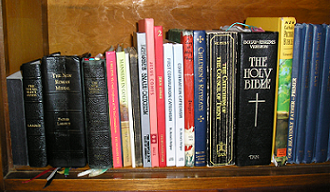 The Baltimore Catechism is based on the Catechism of the Council of Trent.
The Baltimore Catechism is based on the Catechism of the Council of Trent.The Confirmation questions have had fewer changes throughout the years; yet here is one to watch in your catechism: the BC says that Holy Chrism is made of olive oil. The Catechism of the Council of Trent goes further to say that it cannot be "just any" oily greasy substance. That's a certain definition, so it's a good sign of a catechism that you can trust.
If your students are young, you will like the Baltimore Catechism, No. 2. If they're adults, look at the next section to learn about The Catechism of the Council of Trent
More Confirmation catechism explanations here.
5. Catechism of the Council of Trent
High School and Adult Level Catechism
Actually, the Baltimore was based on the early Catechism of the Council of Trent (CCT). Why? The CCT was not widely available, especially in English, till the late 1880s.
The Catechism of the Council of Trent is the definitive catechism that the Church created with purpose to be the catechism that all could use. Pope Saint Pius V helped start it and Saint Charles Borromeo helped finish it. Pretty good recommendations there!
One can go blind sorting through the many variations called the Catechism of the Catholic Church, so it's good for you to read The Catechism of Trent as it is a definitive catechism that no one refutes. I learned many new things in it and found it to be easier to read without the question and answer format of the BC, DeHarbe's (below), or The Catechism Explained.
Learn more about the Catechism of the Council of Trent here. You can buy this catechism at Amazon.
6. Deharbe's Catechism: Small and Large
Grade School and High School Catechism
Deharbe's Catechism is an excellent catechism that was translated into English before the Baltimore.
While the Church was getting The Catechism of Trent published in different languages, the United States needed the catechism in English. The BC is what the Bishops in Baltimore produced to answer this need and was first published in 1885.
Deharbe's Catechism is similar to the BC and was translated from German at the same time, again filling the same need for an English language catechism.
It is not a German catechism specifically, yet the Baltimore was not available at the time that Deharbe's was first translated into English. The earliest version I have seen has Cardinal Wiseman's Imprimatur from 1862.
I found it to have been better in a few places than the old BC, because some of the answers were better.
I have used both of these and found them good:
- Deharbe's Small Catechism is excellent for second through sixth or eighth grade.
- Deharbe's Large Catechism is comprehensive for seventh through twelfth grade.
It was translated for the English and Americans from the German catechism in the 1860s and 1880s. I found no confusing places in either Deharbe's Small Catechism or the Large.
If you are not required to use the Baltimore, check out the old version of DeHarbe's Catechism at Amazon. The Small Catechism is for Communion preparation and The Large Catechism is for the rest of us. No Wite-Out necessary. :-)
7. The Catechism Explained: Baltimore Catechism For Adults
High School and Adult Level Catechism
The Catechism Explained can be bought at Amazon and is a wonderful book that explains the Baltimore Catechism in a way that priests and other adults can use as a reference while keeping the question and answer format.
Depending on your students' reading level this also makes an excellent high school catechism as it incorporates Bible study, saints, liturgy, and some church law into religion class. I like it much better than the BC No. 3, precisely because it adds in Bible and saint stories.
It also seems to give better definitions of Catholic terms in some places than the BC did making it a more definitive manual of the Catholic religion
As old a book as it is, it is nice to see it has an excellent index, which makes it so much easier for you to research real life issues. Having an Index is rare for a book at this time! You can buy it at Amazon here.
8. Saint Anne's Helper Baltimore Catechism PDF Downloads
All Levels: Lower, Middle, High School, and Converts
The Baltimore Catechism books above are the best and most concise books that we have found for teaching the Catholic faith.
At Saint Anne's Helper we have audio downloads, copywork, and booklets for both First Communion and Confirmation. They use the 1959 version of the Baltimore.
Baltimore Catechism 1959 PDF
If you need resources to help you teach catechism, check out these downloads:
- Lower school and auditory learner students can learn from an audio Baltimore Catechism with PDF text. Adults can learn the answers and prayers while driving or doing light chores while listening to the recordings.
- Older students can practice writing and spelling the answers while they also practice handwriting on these printable Baltimore Catechism PDF manuscript and cursive worksheets.
- Homeschool parents love having the audio, worksheets, and illustrated Baltimore Catechism PDF ebooklets so they can teach several levels of children the same answers. (Imagine that! A catechism that stays the same throughout the years. Since 1885.)
Learn more about St. Anne's Helper here.
Order our Saint Anne's Helper products here.
Best Baltimore Catechism Books And Recordings
See more about the 1885 - 21st Century Baltimore Catechisms on these pages:
Saint Anne's Helper Baltimore Catechism
Baltimore Catechism Books And Booklets
TAN Books Baltimore Catechism Complete Set At Amazon
Disclosure: I show products that I think will help you. If you use my links, I may earn ad commissions at no extra cost to you. As an Amazon Associate I earn from qualifying purchases.
Small and Large Deharbe's Catechism
If you are not required to use the Baltimore, check out the old version of DeHarbe's Catechism at Amazon. The Small Catechism is for Communion preparation and The Large Catechism is for the rest of us. No Wite-Out necessary. :-)
9. Baltimore Catechism Ten Commandments
The Baltimore Catechism Ten Commandments are the clearest and easiest to memorize.
They are what are understood to be the Catholic 10 Commandments in English. See the Catholic Ten commandments in order and how they compare to the Protestant Ten Commandments.
We also have Catholic Ten Commandments coloring pages.
Audio Baltimore Catechism, Catholic Worksheets, Catholic eBooks, and Catholic Coloring Pages:
Catholic catechism resources for your Roman Catholic catechism class, Faith formation, Catholic homeschool, religious education, or Sunday school lessons. Save on bundles!
Order our Baltimore Catechism worksheets. Choose your favorite fonts, colors, and SIZES on our fillable digital interactive worksheets and coloring pages. Paperless or printable.
First Communion Preparation Baltimore Catechism No. 1 For Children And Adults - Or get the bundle.
Baltimore Catechism Communion single or bundled downloads: audio, ebooklet, and digital worksheets for kids and adults. Verbatim text in all formats.
